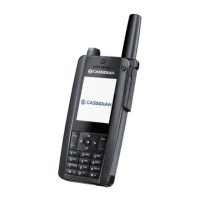
Do you have a question about the Cassidian TH1n and is the answer not in the manual?
| Brand | Cassidian |
|---|---|
| Model | TH1n |
| Category | Portable Radio |
| Language | English |
Formal statement of compliance with EU directives and product recycling information.
Essential safety rules for radio operation, including driving, hospitals, and refuelling.
Instructions regarding pacemaker proximity and switching off radio near medical equipment.
Describes various ways to carry the radio and its magnetic sensor function.
Details on factory settings for phone and security codes and how to change them.
Explains network mode, direct mode, and direct mode repeater mode.
Information on activating/deactivating transmission barring and its network impact.
How to select and use different networks, and service dependency on network.
Guidelines for using the radio in wet environments and handling water exposure.
Details on the man down alarm feature and its user alert/emergency alarm functions.
Explanation of how the radio can be controlled remotely via SDS messages.
Instructions for removing, inserting the battery and charging the radio.
Guidance on installing electromagnetic interference filters for the charger.
Procedures for switching the radio on/off and activating/deactivating keyguard.
Overview of the radio's keys, selectors, and their functions.
Explanation of indicators shown on the display in idle mode.
Description of available call types: Group, Express, and Phone calls.
Information on making red key calls and sending status messages.
Details on the Push-to-Talk (PTT) key and the H/L (duty) key functions.
Information on accessory ports and setting up vibration alerts.
Explanation of icons indicating call status and radio operations.
Descriptions of various notifications that may appear on the display.
Steps to navigate and select functions within the radio's menu system.
How to use the fast menu for quick access to frequently used functions.
Enabling and using voice feedback for radio operations without looking at the display.
Introduction to group calls, scanning, and communication requirements.
Managing talk groups in folders and setting a home group for calls.
How to select folders, talk groups, and configure scanning settings.
Customizing the PTT key behavior for group calls.
Procedures for receiving, responding to, and queuing group calls.
Managing group folders, including copying, deleting, and setting scan priorities.
Steps for initiating and answering express calls between two people.
Using speed dialling and abbreviated TETRA numbers for quick calls.
Instructions for making, answering, and ending phone calls.
Managing calls with transfer functionality and in-call menu options.
Overview of direct mode operation, its limitations, and supported functions.
Steps to activate direct mode, select channels, and groups.
Information on using direct mode gateway and repeater devices.
Making emergency or red key calls when not in network coverage.
Details on the internal GPS receiver, its function, and battery consumption.
Saving, managing, and navigating using waypoints.
Configuring position settings and allowing position information sending.
Connecting to PC via NMEA and setting coordinate display formats.
Using traditional and predictive text input for writing messages.
Instructions for saving, editing, and deleting contact entries.
How to search for contacts and send contact entries to others.
Setting up speed dials and configuring caller groups for phone calls.
Reading, sending, and managing status and callback messages.
Writing, sending, and managing text messages, including templates.
Viewing and clearing call logs, counters, and timers.
Configuring talk groups, profiles, and call settings.
Adjusting language, welcome notes, network selection, and active mode.
Managing access codes, access levels, and keyguard settings.
Overview of available applications like Organiser, Gallery, and Java.
Using the alarm clock, calendar, to-do list, notes, and calculator.
Using the radio for packet data connections and call functions.
Instructions for connecting the radio to a PC for data transfer.
Guidelines for charging, discharging, and maintaining the radio's battery.
Recommendations for protecting the radio, battery, and charger from damage.
Safety rules for radio use in various environments and potential interference issues.
Precautions regarding pacemakers and other medical devices.
Safety instructions for using the radio in areas with explosive atmospheres.
Steps to make an emergency call and available emergency call types.
Information on radio frequency exposure guidelines and SAR values.